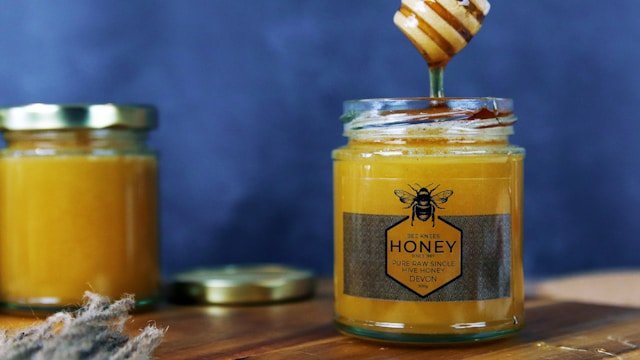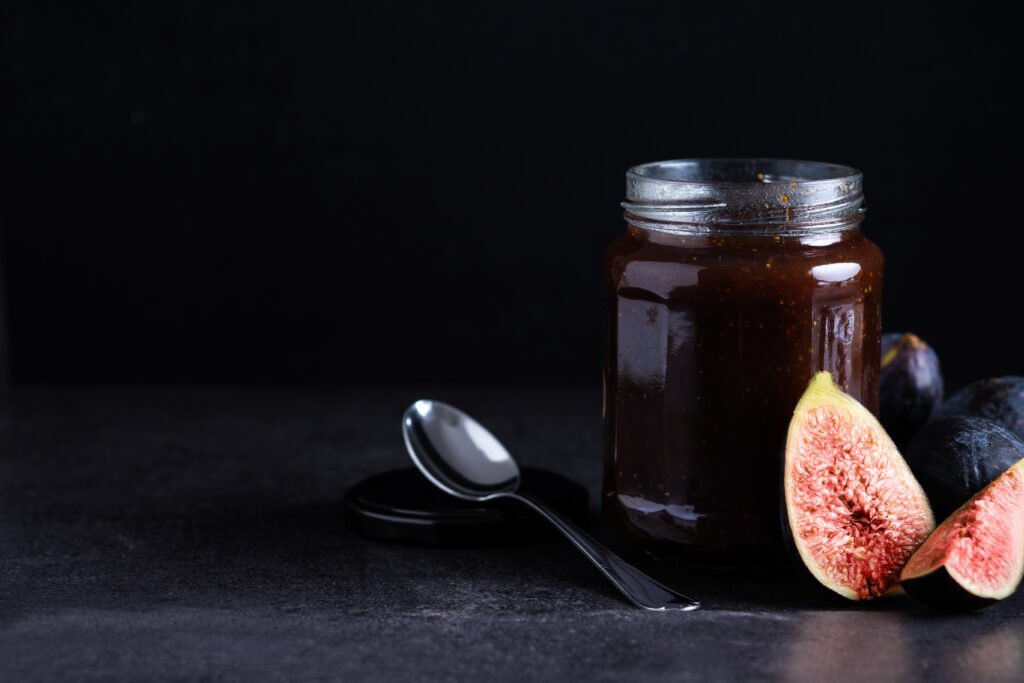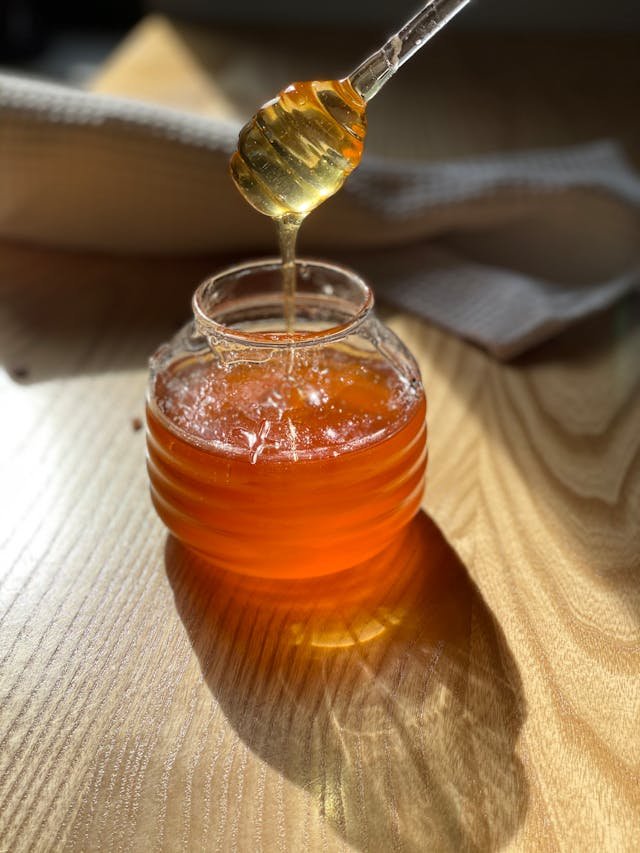Learn what buckwheat honey is, where it comes from, and how buckwheat flowers affect its taste. Also, learn the difference between raw and processed honey.
Introduction to Buckwheat Honey
What is Buckwheat Honey?
Buckwheat honey is a type of dark honey made from the nectar of buckwheat flowers. It has a rich, strong flavor different from lighter honey-like clover. Many people use it for its health benefits and bold taste. It is known for being thick, dark, and full of nutrients.
The Origin of Buckwheat Honey
Buckwheat honey comes from bees that collect nectar from buckwheat plants. Buckwheat is mostly grown in countries like the United States, Canada, and Russia. It has been used for centuries because of its strong taste and health benefits.
How Buckwheat Flowers Affect the Honey
Buckwheat flowers are small and usually dark in color. The nectar from these flowers gives buckwheat honey its dark color and strong flavor. The honey is often thicker than honey made from other flowers.
Raw vs Processed Buckwheat Honey
Raw buckwheat honey is honey that hasn’t been heated or filtered. This keeps more of its natural nutrients. Processed buckwheat honey is often heated and filtered. This makes it smoother but may remove some nutrients.
Health Benefits of Buckwheat Honey

Buckwheat Honey as an Antioxidant Powerhouse
Buckwheat honey is rich in antioxidants. They fight free radicals in the body. A study in the Journal of Agricultural and Food Chemistry found that buckwheat honey has up to 20 times more antioxidants than lighter honey, such as clover honey. These antioxidants reduce inflammation and support heart health. They also cut the risk of chronic diseases.
Buckwheat Honey for Cough and Cold Relief
Research shows that buckwheat honey is great for soothing coughs and colds. A study in Archives of Pediatrics & Adolescent Medicine found that 85% of children given buckwheat honey had less coughing at night. It was shown to be more effective than cough syrups at reducing coughs and improving sleep.
Nutritional Value of Buckwheat Honey
Buckwheat honey is not just rich in flavor; it’s also full of nutrients. It has important minerals like iron, zinc, and magnesium. It also has 16-20 grams of sugar per tablespoon. So, it is a natural energy booster. It also has small amounts of amino acids and enzymes. They help to aid digestion and improve gut health.
Buckwheat Honey for Immune System Support
Buckwheat honey has antioxidants, vitamins, and minerals. They can boost the immune system. A study in the Journal of Food Science found that buckwheat honey boosts the body’s defenses. Its high polyphenol and flavonoid levels reduce the risk of infections. Some studies link regular, small amounts of honey to an 8% drop in seasonal colds.
How is Buckwheat Honey Made?

The Buckwheat Plant and its Role in Honey Production
First, bees collect nectar from the small, white or pinkish flowers of the buckwheat plant. Buckwheat is a fast-growing crop. It thrives in cooler climates, especially in the U.S., Canada, and Russia. The plant blooms for a short period, and during this time, bees work quickly to gather nectar. This nectar is what gives buckwheat honey its dark color and strong flavor.
Harvesting and Processing Buckwheat Honey
Second, after the bees have collected enough nectar, they return to the hive. Inside the hive, bees turn the nectar into honey by breaking down its sugars. Once the honey is ready, beekeepers carefully harvest it from the hive. Honey is extracted from honeycombs. This is done by either pressing or by spinning the combs in a honey extractor. After extraction, the honey may be strained. This removes large particles, like beeswax or pollen.
Raw Buckwheat Honey vs Regular Honey Production
Finally, the honey is either left in its raw form or processed. Raw buckwheat honey is only strained, not heated or pasteurized. This helps keep all the natural nutrients, enzymes, and antioxidants intact. In contrast, regular honey is often heated and filtered to make it smoother and clearer. However, this process can reduce some of the natural health benefits found in raw honey.
This step-by-step process results in the bold, nutrient-rich buckwheat honey.
The Taste and Characteristics of Buckwheat Honey

Flavor Profile of Buckwheat Honey
Buckwheat honey is known for its bold, rich flavor. Buckwheat honey is unlike light honeys, like clover or acacia. It has a distinct, earthy, malty taste with hints of molasses. Some people describe it as having a slight bitterness or tang. A study in the Journal of Sensory Studies found that buckwheat honey is both intense and complex. It is popular with those who prefer stronger honey flavors.
Color and Texture of Buckwheat Honey
Buckwheat honey is one of the darkest types of honey available. It ranges from dark amber to almost black in color. This dark hue comes from the high mineral content, especially iron and manganese. They also give it a rich flavor. The texture of buckwheat honey is typically thick and sticky. Its viscosity is higher than that of lighter honeys, making it slower to pour. The National Honey Board classifies buckwheat honey as a “strong” honey. It ranks it with avocado and eucalyptus honey.
Why Buckwheat Honey is Considered a Strong-Flavored Honey
The strong flavor of buckwheat honey comes from its flower nectar. The International Journal of Food Science found that darker honey has a more complex flavor. This is due to its higher levels of phenolic compounds. These phenolic compounds give buckwheat honey its characteristic earthy and somewhat bitter taste. Its higher mineral content, especially iron, adds to its bold flavor. So, it is a favorite for baking and cooking with hearty dishes.
Buckwheat Honey vs Other Honeys
Buckwheat honey is unique. Its dark color, thick texture, and strong flavor set it apart from other honeys. It appeals to those who prefer a robust, less sweet taste.
Choosing the right honey is more than picking a sweetener. It’s about finding one that suits your health, taste, and lifestyle. Each honey tells its own story. The perfect honey is out there for you. It can be rich and bold or light and floral. Let’s explore the differences between buckwheat honey and other popular honeys. Then, we’ll find out which one suits you best.
Comparison | Buckwheat Honey |
| |
Color | Dark amber to almost black – like nature’s bold embrace | Light to medium amber – warm and golden, like sunshine in a jar | Light golden to pale yellow – soft and gentle on the eyes |
Flavor | Strong, earthy, and malty – a taste that lingers like a memory | Mild, floral, and sweet – a whisper of summer fields | Mild and sweet – like a comforting hug |
Texture | Thick and sticky – a honey that stays with you | Medium viscosity – balanced and easy-going | Smooth, runny – flows like a gentle river |
Antioxidant Content | Rich in antioxidants – a powerhouse of health protection | Moderate – a gentle boost for your wellbeing | Lower than buckwheat or manuka – sweet simplicity |
Health Benefits | Strong immune support, antioxidant-rich – a natural remedy | General immune support, good for allergies – a natural soother | Energy boost, immune support – a classic pick-me-up |
Cough and Cold Relief | Thick and soothing for coughs – like a warm blanket for your throat | Mild relief, soothing – gentle and kind to your throat | Can help soothe but lighter in impact – a comforting touch |
Main Nutrients | Rich in iron, magnesium, zinc – packed with what your body craves | Moderate nutrients – balanced and nourishing | Contains small amounts of vitamins and minerals – light nutrition |
Uses in Cooking | Perfect for baking, hearty dishes – brings bold flavor to life | Best for sweetening, light dishes – easy and adaptable | Ideal for sweetening drinks or light foods – adds a gentle touch |
Price | Affordable – health doesn’t always have to be expensive | Varies by region – a honey for everyone | Affordable – a daily delight that won’t break the bank |
No matter which honey you choose, each is unique. Buckwheat honey has rich health benefits. Clover honey has a delicate sweetness. These honeys are more than ingredients. They’re experiences that bring nature’s goodness into your life.
How to Use Buckwheat Honey
Cooking with Buckwheat Honey: Recipes and Tips
Buckwheat honey adds a rich, earthy flavor to a variety of dishes. Its robust taste pairs well with savory recipes. For instance, it can be used in marinades and glazes for meats. A Journal of Food Science study found that buckwheat honey in marinades can boost flavor and add antioxidants to your meal. When cooking, its strong flavor can dominate. So, start with a little spoon and adjust to taste.
How to Sweeten Beverages with Buckwheat Honey
Buckwheat honey can be used to sweeten both hot and cold beverages. For example, a tablespoon of buckwheat honey in a cup of tea or coffee adds a unique, deep sweetness. A study in the American Journal of Clinical Nutrition says to use buckwheat honey, not refined sugar. It can lower drinks’ glycemic index. This makes them a healthier choice. Buckwheat honey is thick. It’s great for sweetening smoothies and protein shakes.
Baking with Buckwheat Honey: Substitutions and Benefits
When baking, buckwheat honey can be used as a substitute for other sweeteners. For every cup of sugar, use about 3/4 cup of buckwheat honey and reduce the liquid in your recipe by about 1/4 cup. This change is based on the Journal of Agricultural and Food Chemistry. It found that buckwheat honey can add moisture to baked goods. Its rich flavor enhances cookies, breads, and cakes. Also, buckwheat honey’s antioxidants can make baked treats healthier than refined sugars.
Using buckwheat honey in your cooking and baking adds a unique flavor. It also provides health benefits. Buckwheat honey adds a unique touch to your cooking. Use it in a hearty marinade, a soothing tea, or a moist cake.
Skin and Beauty Benefits of Buckwheat Honey

Buckwheat Honey for Skin Care and Face Masks
Buckwheat honey is increasingly popular in skincare due to its nourishing properties. Its thick texture makes it ideal for face masks and scrubs. A Journal of Dermatological Science study found that honey, including buckwheat, moisturizes skin. It can improve hydration by 30% after a few uses. When used in face masks, buckwheat honey can help to hydrate and soothe the skin, leaving it soft and glowing.
Antioxidant and Healing Properties for Skin
Buckwheat honey is rich in antioxidants, which are crucial for skin health. A study in Antioxidants & Redox Signaling found buckwheat honey has high levels of antioxidants and phenolic compounds. They can help to protect the skin from free radical damage. These antioxidants can slow aging and reduce fine lines and wrinkles. Also, buckwheat honey reduces redness and swelling. It can help with various skin conditions due to its natural anti-inflammatory properties.
Buckwheat Honey for Acne and Allergies
For acne, buckwheat honey’s natural antibacterial properties fight acne bacteria. A Journal of Clinical Microbiology study found that buckwheat honey can kill acne bacteria. This includes Propionibacterium acnes. Buckwheat honey’s low pH also helps to prevent bacterial growth. Additionally, its soothing properties can help calm allergic reactions on the skin. A study in the International Journal of Dermatology found that honey can reduce allergic skin reactions by 25%. It can relieve irritation and itchiness.
Using buckwheat honey in your skincare routine can be very beneficial. It can moisturize, reduce aging, and relieve acne and allergies. Buckwheat honey has rich antioxidants and natural healing properties. It would be a good addition to any beauty routine.
Best Places to Buy Organic Buckwheat Honey

Top brands offering organic buckwheat honey include:
- Manuka Health: It is known for its high-quality products. It offers organic buckwheat honey that meets strict quality standards.
- Y.S. Eco Bee Farms: A reputable brand for organic honey, Y.S. Eco Bee Farms provides pure, raw buckwheat honey.
- Honey Gardens: It specializes in raw, organic buckwheat honey. Health enthusiasts love it.
You can find these brands at major health food stores, like Whole Foods, and on Amazon and Thrive Market. The Organic Trade Association says organic honey sales grew 12% last year. This shows a rising demand for high-quality, organic products.
How to Choose High-Quality Buckwheat Honey
To ensure you’re purchasing high-quality buckwheat honey, consider the following tips:
- Color: True buckwheat honey should have a dark amber to almost black hue.
- Texture: It should be thick and sticky. Avoid honey that is too runny.
- Label: Look for labels that confirm organic certification and pure buckwheat honey. Brands like Manuka Health and Y.S. Eco Bee Farms are known for their authenticity and high standards.
- Source: Choose products from reputable brands. The National Honey Board emphasizes that trusted brands offer more reliable quality.
Buckwheat Honey Price Comparison: Local vs Online Stores
Price comparisons for buckwheat honey show variations based on purchasing location:
- Local Stores: At health food stores like as Whole Foods, buckwheat honey from top brands costs $10 to $20 per pound.
- Online Stores: Buckwheat honey on Amazon and Thrive Market costs $12 to $25 per pound. It’s from brands like Manuka Health and Y.S. Eco Bee Farms. Online prices may include shipping. But, they may offer better deals and a wider selection.
For quality buckwheat honey, try these brands: Manuka Health, Y.S. Eco Bee Farms, and Honey Gardens. These brands guarantee high-quality, authentic buckwheat honey. It will meet your taste and health needs, whether you buy locally or online.
FAQs About Buckwheat Honey
Is Buckwheat Honey Safe for Kids?
Buckwheat honey is usually safe for children over the age of one. Under one year old must not take honey. It can cause botulism which is a rare but serious illness. The American Academy of Pediatrics warns that honey is unsafe for babies. For older children, buckwheat honey can be a healthy sweetener. It may also have health benefits.
How Long Does Buckwheat Honey Last?
Buckwheat honey has a long shelf life due to its natural preservatives. When stored in a cool, dry place, away from direct sunlight, it can last indefinitely. The National Honey Board says honey’s high sugar and low moisture prevent bacteria. This lets it stay edible for years. If the honey crystallizes over time, it can be gently heated to return to its liquid state.
Can You Use Buckwheat Honey for Allergies?
Buckwheat honey may help with seasonal allergies. It might be a natural allergen desensitizer. Some studies suggest that local honey can help your body resist local allergens. It may do this by gradually building a resistance to them. A study in the Journal of Allergy and Clinical Immunology found that honey with local pollen might help allergies. However, consulting with a healthcare provider for personalized advice is essential.
What Makes Buckwheat Honey Different from Other Dark Honeys?
Buckwheat honey is distinct from other dark honeys due to its specific source of nectar. Buckwheat honey is different from other dark honeys, like chestnut and eucalyptus. Those have different floral origins. Buckwheat honey comes from the nectar of buckwheat flowers. This source gives dark honeys their strong flavor, dark color, and high antioxidants. It makes them unique. Buckwheat honey has more antioxidants than many dark honeys. That’s according to studies in the Journal of Agricultural and Food Chemistry.
Why is Buckwheat Honey So Dark?
Buckwheat honey’s dark color comes from its high minerals and phenols. They are in the buckwheat nectar. The American Honey Producers Association says that these compounds, in darken the honey to an amber-to-black color. The darker color means a higher antioxidant content. It’s good for health.



